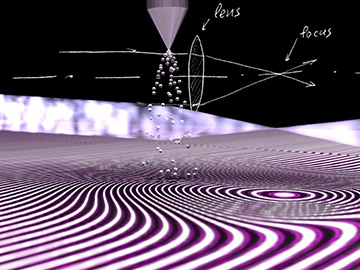
[Image: MBI Berlin]
Extreme-ultraviolet (EUV) radiation is carving out new frontiers in nanolithography, and its short wavelengths and high photon energies also offer a lot of promise for fundamental studies in ultrafast phenomena. But thus far, refractive optics—that is, things like focusing with lenses or splitting light with prisms—has been off the table for EUV radiation. That’s because any matter, including conventional lens materials such as glass, tends to strongly absorb light in this part of the spectrum.
Now, researchers at the Max-Born-Institut (MBI), Germany, have figured out an end run: Make your lens not of glass, but of gas (Nature, doi: 10.1038/s41586-018-0737-3). By using jets of helium or argon with varying geometry or pressure, the team has built unconventional lenses and prisms that can focus and bend EUV beams, without the lossy characteristics and bulk of the customized mirrors commonly used in EUV systems for such functions.
The researchers believe that the technique could open up the power of refractive optics—widely used in microscopy and other applications in different parts of the spectrum—to the EUV band as well.
The pitfalls of strong absorption
EUV radiation covers the wavelength region from 124 nm to 10 nm, with photon energies ranging from 10 to 124 eV. All matter strongly absorbs light at those short wavelengths. That means, among other things, that techniques to manipulate EUV beams need to take place in an ultra-high vacuum.
It also means that focusing and redirecting these beams must rely not on refractive elements (which would absorb too much of the light’s energy to be useful), but on reflective elements such as multilayer Bragg stack mirrors and diffractive Fresnel zone plates. Even these elements tend to absorb a large fraction of the EUV energy in systems such as next-gen lithography platforms; those systems thus must include very bright EUV sources to overcome the losses and get the job done.
Making a prism from gas
Lenses and prisms for EUV radiation, if they could somehow be devised, could considerably improve the flexibility for designing EUV systems, particularly for applications in microscopy and ultrafast phenomena. The MBI team behind the new work, led by Bernd Schütte, wanted to see if it could create such refractive elements in a novel way—by using a stream of gas rather than a conventional solid lens.
In the basic setup, an EUV beam—created via high-harmonic generation from femtosecond-duration near-infrared pulses—is passed, off center, through a pulsed horizontal jet of an inert gas, created using a piezoelectric valve with a nozzle diameter of 0.5 mm. The valve creates a gas stream with a strong vertical density gradient, with high gas densities at the center and lower densities moving radially outward.
As the EUV pulse passes through gas regions of different density, the pulse photons excite the gas atoms, which re-emit radiation at the same photon energy. The re-emitted energy is phase-shifted, with respect to the original pulse, by different amounts for regions of different gas density, which tilts the wavefront. And, because the refractive-index function looks strongly dispersive at energies near the atomic resonance, spectral components of the re-emitted radiation with different photon energies (and wavelengths) near the resonance value “see” a different refractive index, and are bent in different directions. Result: the basis for a refractive prism.
Control knobs
Using these principles, the MBI team was able to create helium-jet prisms capable of bending and splitting EUV light by wavelength when the beam was passed through the gas region off center, much as a glass prism splits visible light. And, when an unfocused EUV beam was passed through the center of the gas jet, rather than off-center, the team found that the density gradient on either side of the gas jet acted as a lens, bending and focusing the EUV beam to a much tighter spot centered beyond the gas jet.
The team also demonstrated that it could control the extent of the deflection (in the prism) and focusing (in the lens) by varying the gas backing pressure, and thus jet’s density profile, or the gas used. An argon lens in the team’s demo, for example, achieved peak focusing at a pressure of around 2.5 bar. At higher pressures, the team says, the focal plane moves closer to the nozzle. That suggests the potential for using pressure as a control knob for tuning the properties of these gas lenses.
Applications in ultrafast studies
In addition to that tunability, the team notes that the gas lenses are highly transmissive to EUV light, “immune to damage (because the gas sample is constantly replenished), and preserve the propagation direction of the incoming light.” And while the focusing demonstrated in these initial experiments was at the micrometer scale, theoretical work, the team says, suggests that combining the technique with another focusing element, such as a Fresnel zone plate, could achieve nanometer-scale focusing of attosecond EUV pulses. That’s a combination of temporal and spatial resolution that could prove quite handy in fundamental studies of electronic properties and the structural dynamics of proteins.
One drawback is that, right now, lenses built with the technique are limited to the relatively long-wavelength, low-energy end of the EUV spectrum—from photon energies of around 10 eV to 24 eV. But the researchers believe that lenses capable of focusing shorter-wavelength, higher-energy EUV radiation are possible, through systems that use plasmas of highly charged ions and electrons, rather than an atomic or molecular gas, as the refractive medium.
